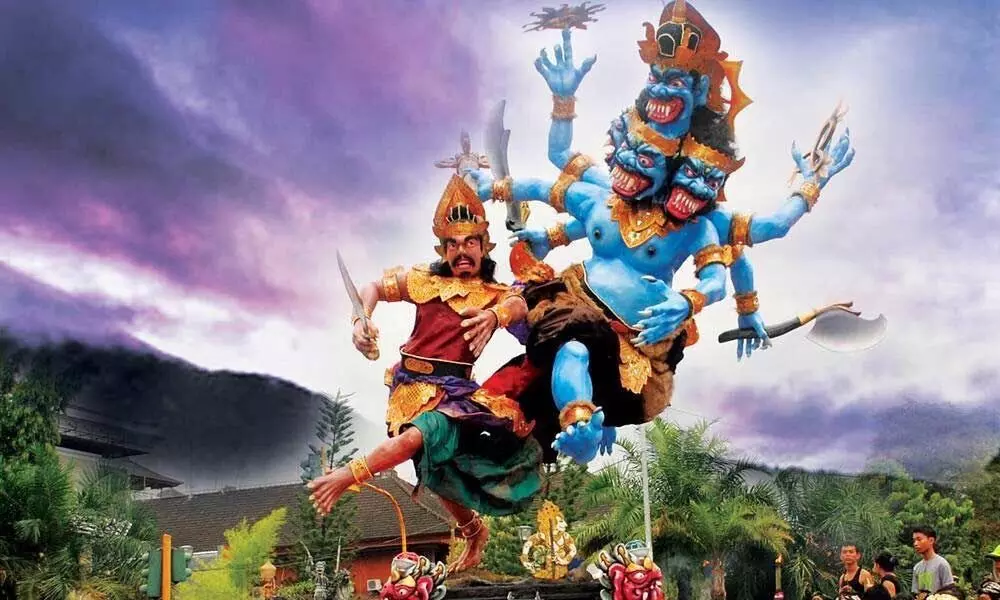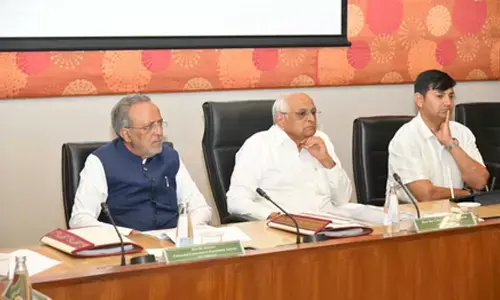Ugadi 2020: New era, new beginnings
 Nyepi Day in Bali
Nyepi Day in BaliCall it Yugaadi or Ugadi, it only means the beginning of the traditional new year for all of us. India is a country with diverse cultures, languages, customs and traditions. Each state co-exists with each other in unity, as all festivals are celebrated with the same fervour, regardless of boundaries and limitations. New year India
If the New Year is addressed as "Ugadi" in Andhra Pradesh, it is called by a different name in another state. The customs and rituals followed may differ, but the essence of the festival remains the same. Ugadi, derived from the Sanskrit word "Yuga" and "Adi" together mean "the beginning of a new age". Based on the lunisolar calendar the day falls on different days every year. For the people of Andhra, 'Ugadi' ushers in the New Year. Chaitra is the first month in Panchanga which is the Indian calendar. The Maharashtrians term the same festival as Gudi Padwa. The Rajasthani's have a different name "Thapna, while it is called Cheti Chand by the Sindhis.
Known as "Sajibu nongma panda" in Manipur, New year is known as "Puthandu" in Tamil Nadu. In Punjab the New year "Baiskahi" is welcomed with great pomp and show.
Cheiraoba is the New Year of Manipur, where people decorate their homes and make special delicacies. After puja, the offering is made to the deity. The festival concludes with climbing a mountain, symbolizing a higher ascent in life.
Nyepi Day in Bali
Elsewhere in Bali and Indonesia, the Hindu community celebrates under a different name "Nyepi". India has always displayed the spirit of unity in diversity. Indian Eagle has the Lowest Airfare guaranteed to persuade you to visit India at any time of the year.
There is however no such uniformity when it comes to several other festivals in India among different regions. This is because of the Calendars that we followed traditionally varied from time to time and region to region and kingdom to kingdom in the past.
The birth of a calendar in the past depended on the King and his court.
Birth of the calender
Take for example the Shaka era is a historical calendar era, the epoch (its year zero) of which corresponds to Julian year 78. It is commonly known in Indian languages as Shalivahana Śaka ("era of Shalivahana") or in Mahasakkarat ("Greater Era") and continues to be used in traditional calendars.
Again, it will be historically inaccurate to equate Shalivahana Saka with Shaka era itself. The origin of Shalivahana era can not be pin pointed. There is also an argument that Shalivahana Shaka is a copy-cat of Vikramasavat (the era of Vikramaditya, the great). (But both the kings or related to Shaka having defeated them in one place or the other at one point of time or the other. We will come to a bit later).
In addition the origin of the Shaka era is highly controversial on another count too.
There are two Shaka era systems in scholarly use, one is called Old Shaka Era, whose epoch is uncertain, probably sometime in the 1st millennium BCE because ancient Buddhist, Jaina and Hindu inscriptions and texts use it, but this is a subject of dispute among scholars. The other is called Saka Era of 78 CE, or simply Saka Era, a system that is common in epigraphic evidence from southern India. A parallel northern India system is the Vikrama Era, which is used by the Vikrami calendar linked to Vikramaditya, Wiki lucidly explains.
The beginning of the Shaka era is now widely equated to the ascension of king Chashtana in 78 CE. His inscriptions, dated to the years 11 and 52, have been found at Andhau in Kutch region.
These years are interpreted as Shaka years 11 (89 CE) and 52 (130 CE), in the epigraphic works. A previously more common view was that the beginning of the Shaka era corresponds to the ascension of Kanishka I in 78 CE. However, the latest research by Henry Falk indicates that Kanishka ascended the throne in 127 CE. Moreover, Kanishka was not a Shaka, but a Kushana ruler. Other historical candidates have included rulers such as Vima Kadphises, Vonones, and Nahapana.
Shalivahana Era
According to historian Dineshchandra Sircar, the inaccurate notion of "Shalivahana era" appears to be based on the victory of the Satavahana ruler Gautamiputra Satakarni over some Shaka (Western Kshatrapa) kings. Sircar also suggests that the association of the northern king Vikramaditya with Vikrama era (also historically inaccurate) might have led the southern scholars to fabricate a similar legend of their own. Another similar account claims that the legendary emperor Vikramaditya defeated the Shakas in 78 CE, and the Shaka era marks the day of this conquest.
This legend has been mentioned in the writings of Brahmagupta (7th century CE), Al-Biruni (973-1048 CE), and others. However, this is an obvious fabrication.
Over time, the word "Shaka" became generic, and came to be mean "an era"; the era thus came to be known as "Shalivahana Saka".
The earliest known users of the era are the Western Satraps, the Shaka (Indo-Scythian) rulers of Ujjain. From the reign of Rudrasimha I (178–197), they recorded the date of minting of their coins in the Shaka era, usually written on the obverse behind the king's head in Brahmi numerals. The use of the calendar era survived into the Gupta period and became part of Hindu tradition following the decline of Buddhism in India.
It was in widespread use by the 6th to 7th centuries, e.g. in the works of Varāhamihira and Brahmagupta, and by the 7th century also appears in epigraphy in Hindu Southeast Asia.
Indian National |Calender
The calendar era remained in use in India and Southeast Asia throughout the medieval period, the main alternative era in traditional Hindu timekeeping being the Vikram Samvat era (56 BC).
It was used by Javanese courts until 1633, when it was replaced by Anno Javanico, a hybrid Javanese-Islamic system. It was adopted as the era of the Indian national calendar (also known as "Śaka calendar") in 1957 but not widely used.
The Shaka era is the vernal equinox of the year AD 78. The year of the official Shaka Calendar is tied to the Gregorian date of 22 March every year, except in Gregorian leap years when it starts on 21 March. The Shalivaahana Saka continues to be used widely in southern India for many religious and some secular purposes such as sowing and agriculture.
Realizing the dangers of such controversies which could spark off serious differences in a country like India, the then Prime Minister, Jawaharlal Nehru appointed a Calendar Committee in 1953 to resolve the differences and formulate a rationale calendar for the country termed as Secular.
Senior Indian Astrophysicist Meghnad Saha was the head of the Calendar Reform Committee under the aegis of the Council of Scientific and Industrial Research. Other members of the Committee were: A. C. Banerjee, K. K. Daftari, J. S. Karandikar, Gorakh Prasad, R. V. Vaidya and N. C. Lahiri. It was Saha's effort, which led to the formation of the Committee. The task before the Committee was to prepare an accurate calendar based on scientific study, which could be adopted uniformly throughout India. It was a mammoth task.
The Committee had to undertake a detailed study of thirty different calendars prevalent in different parts of the country. The task was further complicated by the integration of those calendars with religion and local sentiments.
Jawaharlal Nehru, in his preface to the Report of the Committee, published in 1955, wrote: "They (different calendars) represent past political divisions in the country... Now that we have attained Independence, it is obviously desirable that there should be a certain uniformity in the calendar for our civic, social, and other purposes, and this should be done on a scientific approach to this problem."
Usage started officially at 1 Chaitra 1879, Saka Era, or 22 March 1957. This is of course, matched to some extent with the Gregorian Calendar too. What AIR airs in the morning is this very same calculation.














